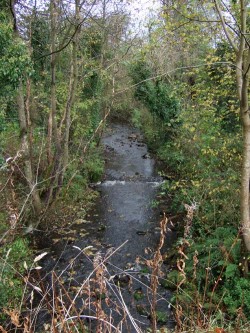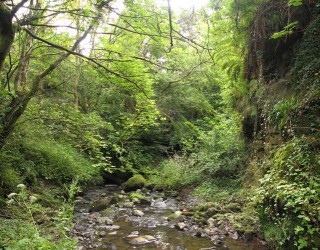Location and Access
Much of the lower part of Kerelaw Glen is sparsely wooded and marred by signs of anti-social behaviour – especially vandalism and littering; however, the stretch of wooded glen upstream from Kerelaw Castle is one of Stevenston’s greatest natural assets. The wood is comprised mainly of Sycamore and Beech, and boasts a few impressive specimens. Although the relevant length of pathway is relatively short (200m), it is worth visiting – not just for the birdlife, but for the picturesque glen, attractive river cliffs, and historic castle and bridge.
 |
 |
It is possible to park in the neighbouring council estate – Campbell Avenue is the nearest street to the castle. Alternatively, one can park in the town centre and walk up to Kerelaw by following the river pathway starting at NS 267 421. If travelling by bus, one can alight at Stevenston Cross or in the neighbouring Hayocks housing estate (the No. 18 goes through Hayocks).
Upstream from Kerelaw Glen it is possible to follow the burn for a few hundred metres (look for the gap in the fence at NS 269 431). However, the path is informal at best and the birdlife in this Hawthorn scrub is not often inspiring. It is quite a pleasant stretch though and is worth exploring.
Glen Banks lies a kilometre upstream from Kerelaw. Unfortunately, one cannot simply follow the Stevenston Burn upstream to reach Glen Banks; from Kerelaw, it can be reached by following the network of country roads for one mile from Kerelaw (NS 269 431), under the bypass (NS 266 436) to the ford (NS 264 438). Glen Banks lies just upstream of the ford. This wooded glen is deceptively long and can be followed upstream for over 500m. Unlike Kerelaw, the wood consists almost entirely of Beech, Elm, Ash, and Hawthorn. Geological features such as river cliffs and a small waterfall add to the glen’s beauty. There is no formal footpath along the glen: it’s a bit of a scramble.
Birds
Some of the more interesting breeding birds at Kerelaw include Blackcap, Chiffchaff, Goldcrest, Treecreeper, Coal Tit, Mistle Thrush, Tawny Owl, and Grey Wagtail. Kestrel and Sparrowhawk are seen throughout the year. Outside of the breeding season things are a lot quieter, but Tit/Finch/Treecreeper/Goldcrest flocks can often be encountered and Great Spotted Woodpecker are occasionally seen. Buzzard frequent the nearby countryside and occasionally visit the glen in winter.
The scrubby stretch of river immediately upstream from Kerelaw Glen supports a typical variety of breeding birds, including Willow Warbler, Whitethroat, Greenfinch, Goldfinch, and Song Thrush. In autumn, the vegetation provides feeding for flocks of Goldfinches and winter thrushes.
Glen Banks supports pretty much the same variety of birds as Kerelaw; however Great Spotted Woodpecker, Long-tailed Tit, and Goldcrest are more often encountered at Glen Banks.
In winter, the stubble fields between Kerelaw Glen and Glen Banks attract Linnet, Skylark, Meadow Pipit, Chaffinch, and the occasional Yellowhammer.
Notes
- Scrambling up the glen at Glen Banks can be quite physically demanding: the burn has to be crossed several times, there is usually a lot of mud to be walked through, and there are several low-hanging tree branches to duck under or climb over. Choosing to explore the glen when the ground is dry will make things a lot easier.
- Although there is no formal footpath at Glen Banks, cows sometimes graze in the glen and so there is a muddy livestock path leading almost all the way upstream. However, this is more of a hindrance than a help because it simply creates more mud to contend with.
- For those who don’t fancy walking up the glen, there is often a surprising amount of birdlife in the area around the ford and it is worth spending a few minutes wandering about here.
- Because of the small size of the woodland at Kerelaw, winter birding can be pretty hit-or-miss.